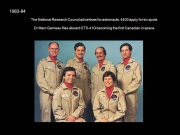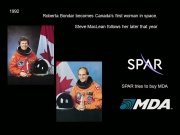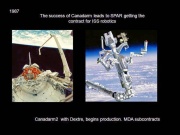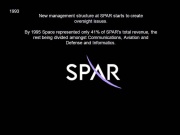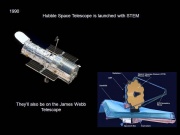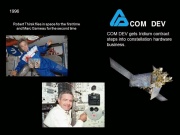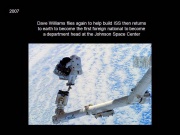100 Years of Aerospace History in Canada: From McCurdy to Hadfield Part 12 by Robert Godwin
From The Space Library
Canadian Astronauts, SPAR's "Deconstruction" and a New, Canadian Space Agency
Long before the establishment of a national space agency, Canadian astronauts began training to fly in space.
On July 14th 1983 the National Research Council (NRC) placed an advertisement in the newspapers inviting candidates to apply for a position as an astronaut to fly aboard the space shuttle. Over 4400 people applied and six were selected. A second group of three was then added nine years later.
Dr Marc Garneau was the first Canadian selected to fly, aboard STS-41G, the thirteenth shuttle mission, on October 5th 1984. Garneau was aboard as a payload specialist and would be involved with a synthetic aperture radar (SAR) experiment placed in the cargo bay and aimed down towards the Earth. This mission helped to reinforce the value of SAR for studying the earth. Garneau also conducted two atmospheric experiments, as well as eight other Canadian derived experiments. He would also be the first Canadian to work with the Canadarm system in space.
Due to the Challenger accident in 1986 another eight years would pass before a Canadian would again fly in space.
This time Dr Roberta Bondar became the first Canadian woman in space aboard STS-42 in January 1992. Dr Bondar would be a payload specialist for the first mission of the International Microgravity Laboratory, which carried experiments from over 200 scientists in 16 countries.
Steve MacLean would follow Dr Bondar into space in October of that year; flying aboard STS-52. Dr. Maclean conducted the CANex-2, which was a package of seven experiments in technology, materials processing and life sciences. Dr Maclean would return to space in September 2006 aboard STS-115 during which he would be the first Canadian to operate the Mobile Servicing System (MSS) aboard the International Space Station (ISS).
Work on the MSS, had begun at SPAR in 1985. At that time SPAR had contracts to supply parts and end-effectors for Canadarm to NASA. The Canadian government then contracted SPAR to put their expertise to good use in creating Canada's contribution to the multi-billion dollar ISS. The Canadian government would spend about $1.5 Billion on the ISS program.[i]
The MSS would consist of several components including the Mobile Base System (MBS); the arm or Space Station Remote Manipulator System (SSRMS), which became known as the Canadarm2; and the hand, or Special Purpose Dexterous Manipulator (SPDM) affectionately known as "Dextre."
The MSS would be launched into space in April 2001 and could handle loads up to 116,000 kg. The MBS would provide the base for the arm and would be built in California by the SPAR subsidiary Astro Aerospace. It would be launched in June 2002. Six years would then pass before Dextre would complete the system; being launched in March 2008.
All of the MSS system would be launched after SPAR's robotics division had been purchased in 1999 by MacDonald Dettwiler and Associates (MDA).
SPAR had gone through a long period of expansion and growth during the 1980s and early 1990s. Their collaboration with Hughes Aerospace had resulted in a string of satellite successes including the ANIK series, the Brasilsat series and the revolutionary MSAT built for TMI Communications & Company Ltd. of Ottawa.
However, at the end of 1993 the Board had elected to give more autonomy to the four separate sectors of the company, removing some of the immediate decision making from the executive management. By 1995 space represented only 41% of SPAR's total revenue, the rest being divided amongst communications, aviation and defence and informatics.[ii]
At one point in the early 1990s it appeared that SPAR might purchase MDA, which was itself struggling at that time; but MDA resolved their problems and soon the restructuring of SPAR's internal processes began to cause problems for Canada's top aerospace company. By 1996 the problems became evident when sales dropped by $25M over the previous year and their share price dropped by almost half. Many of the problems stemmed from the SPAR Comstream Division in California that was expected to go public, but lost its primary customer.[iii]
Between January 1998 and March 1999 an assortment of purchases and sales led to the deconstruction of SPAR Aerospace including the aforesaid purchase of the robotics division by MDA. Hawker-Siddeley had already sold some of the fragments of Avro to Magellan Aerospace in 1995, including the Orenda engine plant. Two years later Magellan also added Bristol Aerospace to their portfolio of companies elevating them to the fourth largest aerospace company in Canada behind SPAR, Bombardier and CAE Industries.[iv]
In early 2000, just before the successful launch of Canadarm2, SPAR would finally be reduced to nothing more than a service company to the aviation industry, thus ending perhaps the single most important story in Canadian space industry. Dr Lapp noted, "SPAR, before its deconstruction, became a huge unmanageable conglomerate with so many moving parts that it became impossible to control effectively." [v]
The STEM however, continued on unabated. Astro Aerospace, the California based company that SPAR had purchased to circumvent the US Congress, is currently a division of Northrop Grumman. The STEMs built there are slated to appear on the multi-billion dollar James Webb Space Telescope.
Despite this serious blow to Canada's aerospace engineering capacity the space program, now firmly centered on the Canadian Space Agency (CSA) in Quebec, continued onwards in many areas. The most highly visible aspect, of course, was the continuing presence of Canadian astronauts aboard the space shuttle and ISS.
Steve MacLean would retire from the astronaut corps and would later assume the role of President of the CSA. His original back-up for his first mission, Bjarni Tryggvason, would fly in August 1997. In 2009 Tryggvason would recreate for the 100th anniversary John McCurdy's historic flight in a replica of Canada's first aircraft, the Silver Dart.
Dr Garneau would return to space twice more, once in 1996 and again in 2000 and would also take on the role of President of the CSA before being elected as a Member of Parliament. Julie Payette would become Canada's most travelled female astronaut with flights in May 1999 and again in July 2009.
Robert Thirsk would fly on STS-78 in 1996 before becoming Canada's first member of an ISS Expedition crew in May of 2009. Dr Thirsk would establish a new record for long duration spaceflight for a Canadian before returning home aboard a Russian Soyuz.
Dafydd Rhys "Dave" Williams flew twice, once in April 1998, during which he conducted many medical experiments with the Neurolab. He then returned to space in August of 2007 and conducted three spacewalks, assisting in the construction of the ISS. He returned to earth and became the first foreign national to assume a senior management position at NASA's Johnson Space Flight Center.
Dr Ken Money had the longest standing relationship with the space program having consulted for NASA as early as the Mercury days in 1962. He was selected as one of Canada's first astronauts but never flew in space, returning to the private sector in 1992.
Finally, Chris Hadfield would fly in November of 1995 and again in April 2001. From 2001-2003, Hadfield was the Director of Operations for NASA at the Yuri Gagarin Cosmonaut Training Centre in Star City, Russia. From May 10 to 23, 2010 Hadfield was the Commander of NEEMO 14, a NASA undersea mission to test exploration concepts living in an underwater facility off the Florida coast. Hadfield would be the only Canadian to board the Russian MIR space station; he would also be the first Canadian to operate the Canadarm in space. He would install the Canadarm2 system aboard ISS becoming at the same time Canada's first space walker.
In December 2012 he launched to ISS aboard the Soyuz TMA 07M, to join Expedition 34, after three months he took over as Commander of ISS, becoming the first Canadian to command a spacecraft. As one of Canada's most traveled and experienced astronauts, much was expected of Hadfield who certainly didn't disappoint. During his command of ISS Expedition 35 Hadfield created a media storm with his regular transmissions to Earth of his daily activities, which included him recording a David Bowie song and video while in space.
Before Hadfield made headlines around the world at least one Canadian imagined a time when Canadian astronauts would be launched into space from Canada.
Footnotes
[i] Phil Lapp Memoir Pg 223
[ii] Ibid. Pg 235
[iii] Ibid. Pg 237
[iv] Globe and Mail Jun 20 1997
[v] Phil Lapp Memoir Pg 240
